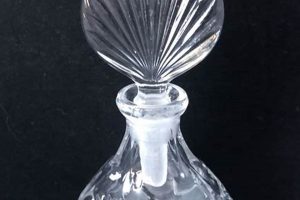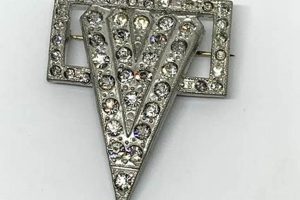These rings represent a distinct style from the 1920s and 1930s, characterized by geometric shapes, bold lines, and symmetrical designs. Frequently incorporating diamonds and gemstones such as sapphires, emeralds, and rubies, these pieces often feature platinum or white gold settings. The use of contrasting colors and step-cut stones are also hallmark characteristics.
Their significance lies in their historical value as examples of a pivotal design movement, and their desirability stems from their unique aesthetics and craftsmanship. The era marked a departure from the flowing, organic forms of the preceding Art Nouveau period, embracing modern industrial influences. Owning such a ring connects the wearer to a period of innovation and glamour, offering a tangible link to the past.
The following sections will delve into the specific design elements, materials, and considerations for those interested in acquiring these unique and historically significant items of jewelry. We will also examine how to assess authenticity and value, ensuring a well-informed decision for potential buyers.
Essential Insights for Acquiring Art Deco Era Diamond Rings
The following information provides critical guidance for individuals seeking to acquire authentic examples from the Art Deco period, ensuring informed decisions and safeguarding against potential pitfalls.
Tip 1: Recognize Defining Characteristics: Familiarize yourself with the geometric patterns, symmetrical designs, and use of contrasting materials that define the Art Deco aesthetic. Look for examples featuring baguette-cut diamonds, calibre-cut gemstones, and intricate milgrain detailing.
Tip 2: Verify Metal Purity: Authentic pieces from this period frequently utilize platinum or white gold. Confirm the metal purity through hallmarks or professional testing to ensure the piece aligns with historical standards.
Tip 3: Examine Stone Cuts and Settings: Art Deco rings often showcase step-cut stones like emerald cuts and Asscher cuts, set in intricate mountings. Inspect the condition of the stones and the security of the settings to identify potential damage or repairs.
Tip 4: Research the Jeweler’s Reputation: When purchasing from a jeweler or antique dealer, thoroughly investigate their reputation and expertise in vintage jewelry. Request documented provenance or appraisals to support the authenticity of the ring.
Tip 5: Understand Gemstone Treatments: Be aware that gemstones used in vintage jewelry may have undergone treatments to enhance their color or clarity. Inquire about any known treatments and their potential impact on the stone’s value.
Tip 6: Assess Overall Condition: Evaluate the ring’s overall condition, considering signs of wear and tear. While some patina is expected in vintage pieces, excessive damage or poorly executed repairs can diminish its value.
Tip 7: Obtain a Professional Appraisal: Prior to finalizing the purchase, secure a professional appraisal from an independent gemologist. This will provide an unbiased assessment of the ring’s value and authenticity, offering peace of mind.
These insights provide a foundation for making sound decisions when selecting from the beautiful examples of jewelry design from this era. Proper due diligence can ensure you acquire an authentic treasure that retains its value and historical significance.
The subsequent sections will provide details about caring for rings to preserve its beauty and integrity.
1. Geometry
Geometry is fundamental to the visual identity of rings from the Art Deco era. The movement, flourishing from the 1920s to the 1930s, embraced machine-age aesthetics, rejecting the organic forms of Art Nouveau in favor of precise, angular designs. This influence directly manifests in these pieces through the prominent use of geometric shapes, creating a sense of order, symmetry, and modernity.
The effects of geometric design are evident in several characteristic features. Step-cut gemstones like emerald cuts, baguette cuts, and Asscher cuts are frequently employed, showcasing clean lines and defined facets. Mountings often incorporate stepped shoulders, triangular motifs, and repeating patterns, further emphasizing the geometric theme. For example, a platinum ring might feature a central emerald-cut diamond flanked by baguette-cut diamonds, all set within a mounting displaying a repeating geometric pattern of triangles. This exemplifies the era’s embrace of geometric precision, resulting in striking visual balance.
Understanding the geometric elements present in these rings is practically significant for several reasons. It aids in authenticating rings from the period, as geometric motifs are a consistent hallmark. Awareness of these design elements facilitates the accurate identification and appreciation of distinctive styles. The geometric aspects also determine value, as the quality of the cut and the complexity of the geometric arrangement contribute to a ring’s overall desirability. These observations enable collectors and enthusiasts to make informed purchase decisions.
2. Materials
The selection of materials is critical in defining authentic rings from the Art Deco era. The period’s distinct aesthetic and technological advancements significantly influenced the metals and gemstones employed, resulting in recognizable characteristics.
- Platinum’s Dominance
Platinum was the metal of choice for finer rings from this time. Its strength, durability, and naturally white hue allowed for intricate settings and showcased the brilliance of diamonds without imparting any yellow tint. Platinum’s high cost and working difficulties also signified luxury and quality, making it a status symbol. Rings featuring complex geometric designs were often rendered in platinum, demonstrating the metal’s capacity to hold fine detail.
- White Gold’s Emergence
White gold, a more affordable alternative to platinum, gained popularity during the late Art Deco period. While lacking the natural whiteness of platinum, white gold offered a similar aesthetic at a lower price point. It was frequently used for simpler designs or settings requiring less intricate detail. However, early white gold alloys could sometimes yellow over time, requiring rhodium plating to maintain their appearance.
- Diamonds: Shapes and Cuts
Diamonds were the central gemstone, but the cuts differed from modern preferences. While round brilliant cuts existed, step cuts like emerald, Asscher, and baguette cuts were more characteristic. These cuts emphasized clarity and geometry over brilliance, aligning with the overall aesthetic. Smaller diamonds were frequently used as accents, framing larger center stones or accentuating geometric patterns.
- Colored Gemstones: Accent and Contrast
Colored gemstones provided contrast and visual interest. Sapphires, rubies, and emeralds were popular choices, often cut into geometric shapes like calibre cuts (small, precisely cut stones) to fit seamlessly into settings. These gems were used to accentuate the angular lines and symmetrical designs of the rings, creating a bold and striking appearance. For example, a ring might feature a central diamond flanked by calibre-cut sapphires, highlighting the geometric arrangement.
The materials used are thus crucial indicators of rings from the Art Deco period, reflecting the style, technology, and economic considerations of the era. Understanding these material choices contributes to the accurate identification, appreciation, and valuation of these pieces.
3. Craftsmanship
Craftsmanship is a defining element of rings from the Art Deco era. The meticulous attention to detail and skilled execution in creating these rings are integral to their enduring value and aesthetic appeal. Understanding the characteristics of the craftsmanship informs appreciation and evaluation.
- Intricate Metalwork
Art Deco pieces frequently exhibit complex metalwork, including filigree, milgrain detailing, and engraving. These techniques demanded considerable skill and precision, often executed under magnification. Filigree involved creating delicate, openwork patterns from fine wires, while milgrain entailed adding tiny beads along the edges of settings, enhancing their visual appeal and perceived value. These intricate details underscore the dedication and expertise of the artisans.
- Precision Stone Setting
The accurate setting of gemstones, particularly calibre-cut stones, was crucial. Calibre cuts, precisely shaped to fit specific areas within a design, required meticulous planning and execution. Each stone had to be perfectly aligned and securely held in place, ensuring the overall integrity and aesthetic harmony of the ring. Skilled stone setters devoted significant time and effort to achieve this level of precision, which is now a hallmark of authentic pieces.
- Use of Specialized Tools and Techniques
Artisans employed a variety of specialized tools and techniques to create these rings. Hand-fabrication was common, with individual components painstakingly shaped and assembled. Soldering, polishing, and finishing were performed with exceptional care to achieve a high level of refinement. The expertise required to manipulate platinum, a notoriously difficult metal to work with, further highlights the specialized skills of Art Deco jewelers. Examples included using a saw for piercing the metal to create intricate patterns, burnishers to set stones in place, and polishing tools to achieve a smooth finish.
- Hallmarks and Maker’s Marks
Many pieces bear hallmarks indicating metal purity and maker’s marks identifying the workshop or designer. These marks are invaluable for tracing the provenance and authenticity of rings, providing insights into their origin and construction. Recognizing these marks requires knowledge of historical jewelry makers and their respective signatures, adding another layer to the appreciation of craftsmanship.
The superior quality of craftsmanship, evident in the intricate details, precise stone setting, specialized techniques, and informative hallmarks, serves as a benchmark for evaluating rings from the Art Deco era. Recognizing these features enhances appreciation for the artistry and provides tools to distinguish authentic examples from reproductions or later imitations. This quality contributed significantly to the lasting appeal and value.
4. Provenance
Provenance, in the context of rings from the Art Deco era, refers to the documented history and chain of ownership of a particular item. It is a critical factor influencing authenticity, value, and desirability, as it provides verifiable information about the ring’s origins and journey through time.
- Establishing Authenticity
Documented provenance can corroborate the ring’s creation during the Art Deco period (roughly 1920-1939) and confirm the use of materials and techniques consistent with that era. Original sales receipts, estate inventories, or historical photographs depicting the ring being worn can provide concrete evidence. For example, an original receipt from a renowned jeweler of the period, such as Cartier or Tiffany & Co., significantly bolsters confidence in the piece’s legitimacy and value. Without such documentation, authentication relies more heavily on stylistic analysis and material testing, which are less definitive.
- Enhancing Value and Desirability
Rings with verifiable provenance command higher prices and are more sought after by collectors and enthusiasts. A well-documented history, particularly if associated with a notable individual or event, adds a layer of prestige and intrigue. A ring known to have been owned by a prominent social figure of the era, supported by documented evidence, becomes more than just a piece of jewelry; it becomes a tangible link to history. This historical association enhances the emotional connection for potential buyers, driving up its desirability.
- Tracing Repairs and Alterations
Provenance can also reveal a ring’s repair or alteration history. Documentation may indicate when and by whom repairs were performed, which materials were used, and whether any modifications were made to the original design. This information is essential for assessing the ring’s overall condition and originality. Significant alterations or poorly executed repairs can negatively impact value, while sympathetic restorations by reputable jewelers may be viewed more favorably.
- Identifying Theft and Forgery
A clear chain of ownership helps prevent the acquisition of stolen or forged rings. Thorough due diligence, including verifying the provenance with relevant authorities or databases, is crucial to ensure the ring is legally obtained and not a reproduction passed off as an original. A break in the chain of ownership or conflicting documentation can raise red flags, suggesting potential issues with the item’s authenticity or legality.
The presence or absence of robust provenance significantly impacts the assessment of rings from the Art Deco era. A well-documented history provides confidence in authenticity, enhances value, and adds a captivating narrative, making the ring more than just an object, but a tangible piece of history.
5. Rarity
The relative scarcity of specific designs and materials significantly impacts the desirability and valuation of engagement rings originating from the Art Deco period. Rarity in these rings is determined by several factors, including the limited production runs of certain styles, the availability of particular gemstones, and the preservation of pieces in original condition. The less common a design or the materials utilized, the more sought after the piece becomes by collectors and enthusiasts, leading to an increase in its market value. For instance, a ring featuring a rare Kashmir sapphire or a unique geometric arrangement that deviates from typical Art Deco patterns would command a premium due to its exceptional nature.
The effect of rarity is amplified by the historical context of the Art Deco era. The period, spanning roughly from the 1920s to the late 1930s, was marked by significant economic and social changes. The Great Depression, in particular, impacted the availability of luxury goods and the demand for high-end jewelry. Consequently, certain designs were only produced for a limited time, making them increasingly scarce in the present day. Furthermore, platinum, a favored metal during this period, was subject to wartime restrictions, further limiting its use in jewelry production. Understanding the historical conditions surrounding the manufacture of rings allows for a more nuanced appreciation of their scarcity and inherent value.
Recognizing the role of rarity in rings from the Art Deco period is practically significant for prospective buyers and collectors. It necessitates meticulous research and careful examination of potential purchases. Factors such as the design’s uniqueness, the gemstones’ origin and quality, and the overall condition must be assessed in conjunction with the ring’s documented history. While common designs are still desirable, truly rare examples represent significant investments and hold a distinctive place within the historical narrative of jewelry design. The inherent challenge lies in accurately assessing rarity, which requires specialized knowledge and, in many cases, professional appraisal.
6. Condition
The condition of rings from the Art Deco era is a primary determinant of their value, desirability, and historical significance. Degradation caused by wear, improper storage, or insensitive repairs can substantially diminish the ring’s aesthetic appeal and structural integrity. Damage such as chipped gemstones, worn metalwork, or poorly executed sizing adjustments directly impacts the ring’s market price. For example, a ring featuring a pristine emerald-cut diamond in its original mounting will command a premium over an identical ring with a damaged or replaced stone.
Furthermore, original condition is crucial for preserving historical accuracy. Alterations such as replacing original gemstones with modern cuts or modifying the metalwork to suit contemporary tastes compromise the ring’s authenticity and dilute its connection to the Art Deco period. Restorations should be undertaken with care, utilizing period-appropriate materials and techniques to maintain the ring’s original character. A ring with minimal alterations and well-documented repairs executed by skilled artisans retains more of its historical and artistic value. Conversely, over-polishing or aggressive cleaning can remove delicate details, such as milgrain, diminishing the ring’s charm.
In conclusion, evaluating the condition of rings from the Art Deco era requires careful consideration of both aesthetic and historical factors. Prospective buyers should prioritize rings in the best possible original condition, seeking professional assessments to identify potential issues. While some degree of wear is to be expected in vintage pieces, excessive damage or insensitive restorations can significantly detract from their value and appeal. Understanding these considerations ensures informed decisions, preserving the integrity and beauty of rings from this influential design movement.
7. Value
Assessing worth in the context of rings from the Art Deco era involves a complex interplay of tangible and intangible factors. Objective measurements, such as material composition and gemstone characteristics, are weighed against subjective elements, including design aesthetics and historical significance. This multifaceted evaluation dictates market prices and influences investment decisions.
- Material Composition and Quality
The inherent worth of the materials comprising a ring significantly contributes to its overall value. Rings crafted from platinum, a durable and hypoallergenic metal, typically command higher prices than those made from white gold. Similarly, the quality, cut, clarity, and carat weight of diamonds and colored gemstones directly impact the ring’s monetary value. For example, a ring featuring a flawless, D-color diamond will be significantly more valuable than one with imperfections or lower color grading.
- Design and Craftsmanship
The artistry and skill involved in the ring’s creation influence its valuation. Intricate geometric designs, hand-fabricated metalwork, and precision stone setting techniques enhance the ring’s aesthetic appeal and perceived value. Pieces from renowned jewelers or designers, such as Cartier or Tiffany & Co., often command premiums due to their historical significance and reputation for exceptional quality. A ring exhibiting meticulous craftsmanship and unique design elements will invariably be more valuable than a mass-produced or poorly constructed piece.
- Historical Significance and Provenance
A documented history and verifiable chain of ownership can substantially increase the ring’s worth. Rings with connections to notable individuals, historical events, or prestigious collections are highly sought after by collectors and enthusiasts. Provenance provides a tangible link to the past, adding an emotional and historical dimension to the ring’s value. Original sales receipts, estate inventories, and historical photographs serve as compelling evidence of the ring’s authenticity and provenance, driving up its market price.
- Market Demand and Rarity
Supply and demand dynamics play a crucial role in determining the value of rings from the Art Deco era. Scarce designs, limited-edition pieces, and rings featuring rare gemstones are subject to heightened demand, resulting in increased prices. The overall condition of the ring also influences its value, with pieces in pristine or near-mint condition commanding premiums. Market trends and collector preferences fluctuate over time, impacting the relative worth of different styles and materials. Independent appraisals provide objective assessments of value based on current market conditions.
In summary, establishing value for a ring from the Art Deco era requires a holistic assessment encompassing material quality, design characteristics, historical significance, and market dynamics. Informed buyers consult with experienced appraisers and conduct thorough research to ensure their investment aligns with the ring’s intrinsic worth and long-term appreciation potential. These antique engagement rings reflect a combination of elements beyond just their material worth, a testament to the timeless appeal of this era.
Frequently Asked Questions About Art Deco Era Diamond Rings
The following questions and answers address common inquiries regarding the identification, acquisition, and preservation of rings from the Art Deco period.
Question 1: How does one differentiate a genuine ring from the Art Deco period from a modern replica?
Authentic pieces typically exhibit geometric designs, step-cut diamonds (emerald, Asscher, baguette), and intricate metalwork such as milgrain. Hallmarks indicating platinum or white gold purity are also common. Modern replicas often lack the precision and detail of original examples.
Question 2: What are the key characteristics to look for when assessing the condition of an antique engagement ring?
Examine the ring for chipped or damaged gemstones, worn metalwork, and evidence of poorly executed repairs. Check the integrity of the stone settings and the overall structural stability of the piece. Originality is also important; any non-original replacements should be noted.
Question 3: Does the presence of repairs or alterations diminish the value of a vintage ring?
Yes, substantial repairs or alterations can negatively impact the ring’s value, particularly if they compromise the original design. However, sympathetic restorations performed by skilled artisans using period-appropriate materials may be viewed more favorably.
Question 4: What role does provenance play in determining the worth of an antique ring?
A well-documented history, or provenance, can significantly enhance the ring’s value. Original sales receipts, estate inventories, or photographs can provide evidence of authenticity and historical significance, increasing its desirability among collectors.
Question 5: Why was platinum so prevalent in jewelry from the Art Deco era?
Platinum’s strength, durability, and natural whiteness made it the preferred metal for showcasing diamonds without imparting any yellow tint. It allowed for intricate designs and provided a luxurious aesthetic, aligning with the opulence of the period. It’s high workability allowed for more details to be added as well.
Question 6: What factors should one consider when selecting an appropriate insurance policy for an antique ring?
The insurance policy should cover the ring’s appraised value, including protection against loss, theft, and damage. Review the policy’s terms and conditions regarding deductible amounts, coverage limits, and the process for filing a claim. Ensure the policy covers the full replacement value and not just market value.
These answers provide a foundation for understanding the key considerations when dealing with rings from the Art Deco period. Careful research and professional consultation are crucial for making informed decisions.
The following sections delve into the specific considerations for maintaining and caring for these delicate heirlooms.
Conclusion
The examination of rings from the Art Deco era reveals the multifaceted factors influencing their allure and value. Understanding the defining characteristics, material composition, craftsmanship, provenance, condition, and rarity is essential for informed acquisition and appreciation. These elements converge to determine the worth of each piece, guiding prospective buyers through the complexities of the market.
The information presented encourages careful consideration and due diligence when engaging with these historical treasures. Preservation of their integrity and historical significance remains the responsibility of owners and enthusiasts. Rings from this period serve as enduring testaments to an era of innovation and artistry, deserving recognition and protection for future generations.







